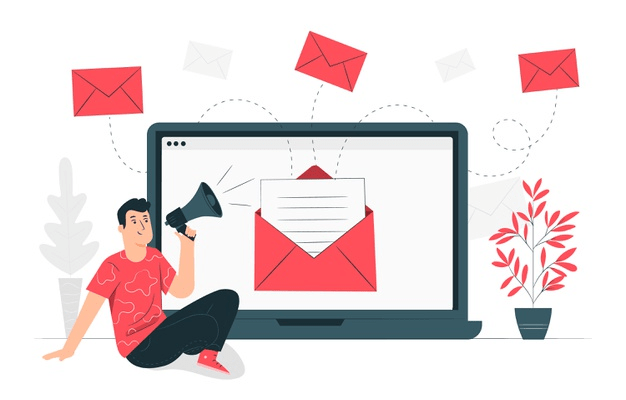Newsletters are the handiest of tools when you’re looking to reach existing and new customers. They are a cost-effective solution to all your customer engagement woes, and it’s about time you try it out.
Newsletters have faced significant criticism in the past. Regardless, it’s a time-tested solution that’s helped businesses gain customers and conversions.
For a B2B eCommerce business, newsletters are an essential tool. Highly-targeted, they make customer conversions and retainment a lot easier.
In this post, we’ll be discussing six of the best strategies for creating conversion-focused email newsletters. If you know what you’re doing, you’ll be able to improve your customer retention by a significant margin.
Highlights of Contents
1. Use Storytelling in Your Newsletter

A newsletter is just an email if it doesn’t capture the audience’s attention. By “capture”, we mean that readers should relate to it on some level.
Storytelling is a must-have superpower in this case.
Though niche-specific, such stories are highly effective in keeping your audience hooked. Since they appeal at the emotional level, such stories can help deliver your brand’s message.
Now, you might argue that B2B eCommerce purchases are driven by rational thought and in general, are less emotional compared to B2C purchases. Well, you would be right, but it doesn’t mean that business-to-business relationships don’t involve emotions at some level.
For example, you can describe the importance of buyer-supplier relationships and how difficult it is in the B2B sphere to switch either one of the two.
Again, you don’t have to go beyond your niche to tell an irrelevant story. Stay within the relevancy to deliver your point while telling a convincing story.
Often, we’ve seen people make the mistake of speaking to the company rather than the individual. It is highly ineffective since it doesn’t allow you to reach out emotionally.
2. Focus on The Customer

When you’re too focused on the sale, you tend to lose sight of the customer.
If you play your cards right, then yes, you can make the sale. However, in the long run, you’re losing a share of your customers who would have come back if you had focused on retaining strategies.
The quick win approach in the B2B newsletter is just not practical. Don’t try to over-promote your products or services. Instead, mix the first tip with a non-sales sales-pitch. It creates situations where the reader is hooked with your content. At the same time, they are also advertising your products and services.
If you’re doing content marketing, it’s useful to add snippets of your blog into the newsletter. If you’re selling a B2B product or service, you can include discount coupon offers or general information related to your work.
This way, not only are you selling; you are keeping the users hooked with your story content.
3. Build Authority Within Your Site

The blog section of your website is the best place to go long-form with your content and describe all the latest industry research. Your newsletter is the second-best place to do that, albeit in short-form.
From a content marketing perspective, you should use both long and short-form content in harmony. For example, if you’re writing an investigative B2B report, you can gain more readership through boiling that content down in your newsletter.
By regularly posting newsletters in such a manner, you can add value to the newsletter. Also, you’re building more authority for your brand.
4. Get Straight to The Point

From the outset, this step might look like a total 360 from what we discussed in the first tip, but it’s not.
Yes, you should include storytelling, but it shouldn’t be so long that you let go for brevity. Keep it concise, to the point while keeping the reader engaged. The following is an ideal workflow for your newsletter.
- Go directly to the point: You have limited real estate, so make sure to use it wisely.
- Discuss actionable tips: If you have some information you’d like to share, share them first or seamlessly with your introductory copy.
- Create a case-study: Mix up your copy with cases that take the point across in a simplistic manner.
- Further reading: Don’t keep the reader to the newsletter. Create links that redirect users to your other relevant content.
5. Be Consistent in Your Newsletters

There is a certain balance you need to maintain in your newsletters.
When sending out newsletters, you need to stick to a consistent schedule. Posting too much or posting also less can both prove to be a hurdle to your customer relationships. We’re not just theorizing here; you can A/B test your frequency and see the difference yourself.
The ideal posting schedule should be a bi-monthly newsletter that has plenty of research involved in it.
It helps you establish yourself as sort of a “thought-leader” in the industry since a) you’re adding value with a wonderfully copywritten newsletter, and b) you’re including statistics and case studies that are aimed at informing the audience.
If your older content is timeless, you can even repurpose it in your newsletters to capture the audience even further. If not, you can update and utilize it.
6. Utilize a Catchy Subject Line and Design

Now that we’re done with the body content, it’s time we move on to the design and subject line of your content.
The goal with a subject line is to, again, make the content resonate with the audience. Now, you have even less real estate, so you have to be extra careful with what you’re trying to write. Effective business communication is an essential aspect of a good subject line.
Technically speaking, the limit of your subject line content should be 4-7 words. Beyond that, you’re compromising readability.
Another thing to look out for is the title itself. It should be thought-provoking and engaging. Clickbait should be avoided since it doesn’t coincide with B2B at all.
Now, let’s talk about design.
When you’ve done everything that you can with regards to content, why compromise on design? Your design should be as engaging and effective as your content. The color schemes, visual design, and all the other design-savvy tasks should revolve around your brand’s voice.
B2B Newsletters Examples
Now that we’ve discussed hypotheticals, it’s time we go practical and look at examples of successful real-world newsletters.
1. Artifact Uprisin
This is one of our favorite newsletters. At the top, they have neatly arranged their products as a clickable element. In the next fold, they’ve highlighted their main content piece that’s very sleek and eye-catching. In addition to that, they’ve got a clear CTA with monochromatic colors.
Being a company that sells artistic photography paraphernalia, it shouldn’t come as a surprise that they would create such a design-savvy newsletter.
2. SalesForce Exact Target Marketing Cloud
The newsletter shows a wonderfully designed podcast advertisement. Coming with different content buckets with their own respective CTA’s, they display the value the brand has to offer. On top of that, they’ve also advertised an event without being too pushy. In fact, mild advertisement has been their forte through the newsletter.
3. InVision
InVision’s newsletter stands out with its educational content. The email divides its blog content into blocks that make the content readable. With illustrations and high-quality photographs, they make the content even more compelling. All of this makes for content that’s digestible and draws more clicks.
4. SalesForce

In this one, SalesForce highlights new content by showcasing high-quality illustrations, concise descriptions, and perfectly-placed CTA’s that make for a better reading experience.
5. Premier Agent
Last, but not least, we have Premier Agent that offers real-estate information and deals in this newsletter. First off, it highlights a personalized touch to readers in the letter. Next, it showcases a list of first-person interviews. Also, with clear CTA’s, it displayed links to online and offline events.
Conclusion
The B2B buying cycles are a lot longer and complicated than B2C. To that end, you should hire a conversion-focused marketing team. Having such resources enables you to deliver serious value in your processes. With these best practices for newsletters in mind, you will be better able to cater to your B2B audience.
We’ll end this post by saying that the B2B industry is enormous. These tips focus on the general B2B audience. You can adjust your content based on the audience present within the article.

Useful information, B2B email newsletters are one of the essential parts of the corporate world.